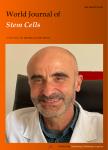Search for naive human pluripotent stem cells
作者机构:National Laboratory of Embryonic Stem Cell Department of Genetics and Evolutionary Biology University of Sao Paulo Sao Paulo 05508-090 Brazil
出 版 物:《World Journal of Stem Cells》 (世界干细胞杂志(英文版)(电子版))
年 卷 期:2015年第7卷第3期
页 面:649-656页
核心收录:
学科分类:0831[工学-生物医学工程(可授工学、理学、医学学位)] 0710[理学-生物学] 1001[医学-基础医学(可授医学、理学学位)] 100101[医学-人体解剖与组织胚胎学] 10[医学]
基 金:Conselho Nacional de Desenvolvimento Cientifico e Tecnologico/Departamento de Ciencia e Tecnologia do Ministerio da Saude(CNPq/MS/DECIT) Banco Nacional de Desenvolvimento Economico e Social(BNDES) Financiadora de Estudos e Projetos(FINEP) the fellowship from CNPq(Costas RM) a fellowship from Coordenacao de Aperfeicoamento de Pessoal de Nivel Superior(Fonseca SAS)
主 题:Naive pluripotent stem cells Epiblast stem cells X chromosome inactivation Human embryonic stem cells
摘 要:Normal mouse pluripotent stem cells were originally derived from the inner cell mass(ICM) of blastocysts and shown to be the in vitro equivalent of those pre-implantation embryonic cells, and thus were called embryonic stem cells(ESCs). More than a decade later, pluripotent cells were isolated from the ICM of human blastocysts. Despite being called human ESCs, these cells differ significantly from mouse ESCs, including different morphology and mechanisms of control of pluripotency, suggesting distinct embryonic origins of ESCs from the two species. Subsequently, mouse pluripotent stem cells were established from the ICMderived epiblast of post-implantation embryos. These mouse epiblast stem cells(Epi SCs) are morphological and epigenetically more similar to human ESCs. This raised the question of whether cells from the human ICM are in a more advanced differentiation stage than their murine counterpart, or whether the available culture conditions were not adequate to maintain those human cells in their in vivo state, leading to a transition into Epi SC-like cells in vitro. More recently, novel culture conditions allowed the conversion of human ESCs into mouse ESC-like cells called nave(or ground state) human ESCs, and the derivation of nave human ESCs from blastocysts. Here we will review the characteristics of each type of pluripotent stem cells, how(and whether) these relate to different stages of embryonic development, and discuss the potential implications of nave human ESCs in research and therapy.



